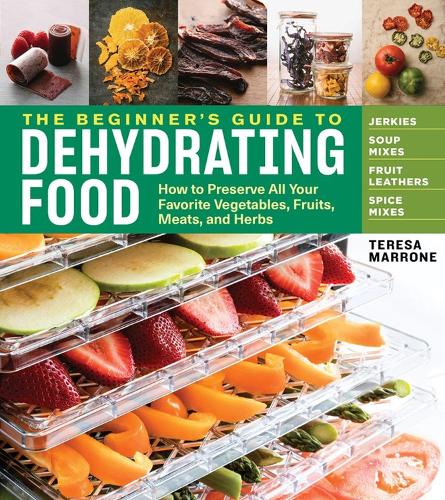
Beginner's Guide to Dehydrating Food: How to Preserve all Your Favorite Vegetables, Fruits, Meats and Herbs
(Paperback)
Publishing Details
Beginner's Guide to Dehydrating Food: How to Preserve all Your Favorite Vegetables, Fruits, Meats and Herbs
By (Author) Teresa Marrone
Workman Publishing
Storey Publishing LLC
12th June 2018
12th June 2018
United States
Classifications
General
Non Fiction
Cooking with specific gadgets, equipment, utensils or techniques
Reference works
641.44
Physical Properties
Paperback
320
Width 202mm, Height 226mm, Spine 18mm
800g
Description
With tabletop food dehydrators more affordable than ever, creating dried fruits, fruit leathers, dried beans, meat jerky, and herb and spice blends at home is easy, safe, and satisfying. The Beginner's Guide to Dehydrating Food, 2nd Edition provides photographic step-by-step instructions and detailed guidelines on drying and enjoying 80 popular foods. Dehydration is one of the simplest, safest, and time-tested methods of food preservation. This photographic guide to drying dozens of fruits, vegetables, herbs, and meats offers detailed instructions on every aspect of the process, from preparation techniques to calculating yield and assessing doneness. Readers will also learn how to rehydrate and prepare each food in the tastiest way and discover how easy it is to dry beans and peas for soup mixtures, create meat jerky and fruit leathers to take on camping and hunting expeditions, prepare the most flavorful dried herb and spice blends to stock the pantry, and more. AUTHOR: Teresa Marrone is the author of several cookbooks, field guides, and regional books. She is very active in her local food scene and has written food-related profiles and features for a variety of magazines. SELLING POINTS: . Food drying at home is an easy, appealing preserving technique. A tabletop electric dehydrator costs as little as $35 and requires very little labour and minimal monitoring. . Detailed instructions for 80 of the most popular fruits, vegetables, meats, and herbs. Includes favourites like dried apricots and figs, apple rings, fruit leathers, bean and pea soup mixtures, meat jerky, and herb and spice blends. . Perfect for campers, hunter, homesteaders, and gardeners. Food dehydration is an economical and easy way to store surplus produce. Lightweight and requiring no canning or refrigeration, dried foods are easy to transport and carry in a backpack for camping or travelling. Full-colour; photographs and illustrations throughout
Reviews
"Simple and easy, dehydrating foods intensifies their natural delicious flavors so they're ready for snacking and to add to your favorite soups and stews, cakes, and cookies. This book is chockfull of practical advice and plenty of wisdom." Beth Dooley, author of In Winter's Kitchen
"Food dehydration is preservation at its purest, oldest, humblest form. If you thought you would be just drying your fruits and vegetables, keep reading. Soon you will be making your own dried snacks and soups, even cereal--for convenience, backpacking, or gifts." Kirsten Shockey, author of Fermented Vegetables and Fiery Ferments
"In this era of super storms, having a supply of dehydrated foods just makes sense, and this is the book to guide you on your path." Andrea Chesman, author of The Pickled Pantry and The Backyard Homestead Book of Kitchen Know-How
"The most comprehensive book on drying food I have ever seen." Barbara Pleasant, author of Homegrown Pantry
"Indispensable for anyone diving into the cost-saving, flavor-boosting world of home preservation." Alana Chernila, author of The Homemade Pantry and Eating from the Ground Up
Author Bio
Teresa Marrone is the author of several cookbooks, field guides, and regional books. She is very active in her local food scene and has written food-related profiles and features for a variety of magazines. She lives in Minneapolis, Minnesota.
